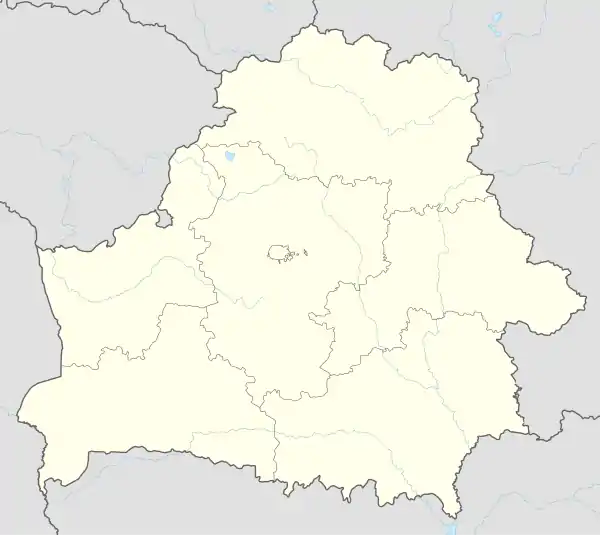Chachersk
Chachersk (Belarusian: Чачэрск, [tʂaˈtʂɛrsk], Russian: Чечерск, Polish: Czeczersk) is a city in the Gomel Region of Belarus, an administrative center of the Chachersk district. It is located in an area which is highly contaminated due to the fallout of the Chernobyl disaster.[1]
Chachersk
Чачэрск | |
|---|---|
 | |
 Flag  Coat of arms | |
 Chachersk | |
| Coordinates: 52°54′58″N 30°54′58″E | |
| Country | |
| Region | Gomel Region |
| Founded | 1159 |
| Government | |
| • Chairman | Igor Aslyuk |
| Area | |
| • Total | 8.2 km2 (3.2 sq mi) |
| Elevation | 146 m (479 ft) |
| Population (2020) | |
| • Total | 8,730 |
| • Density | 1,100/km2 (2,800/sq mi) |
| Time zone | UTC+2 (EET) |
| • Summer (DST) | UTC+3 (EEST) |
| Postal code | 27152 |
| Area code(s) | (+375) 2332 |
| Website | Official website |
History
The town was founded in the late 10th century on the Sozh River. It was first mentioned in chronicles in 1159 as the city Radimichi Chachersk. Sometime later a castle was built in the area.
In 1772 it became part of Russia, as the center of the county in the province Rogachev, then borough, and parish center of Rogachev district. In 1774 Catherine II of Russia in collaboration with a local governor helped build the town hall, churches, a theater, 2 hospitals, and other notable buildings. Redevelopment of the city took place, with the destruction of the castle and the fortifications, which were mentioned more in the "Census" Chachersk for 1765. There are two surviving unique sights of the 18th century - the Holy Transfiguration Church and Town Hall in Chachersk. The Holy Transfiguration Church was built in classicism style 1783 and has international architectural worth.
During Operation Barbarossa in 1941, Nazi Germany captured the town and established a ghetto for Chachersk's Jewish population. The Jews of Chachersk, as well as neighboring Romani, were eventually exterminated in December 1941.
Since 1919, Chachersk has been part of Gomel province in the RSFSR. It officially became a town in 1971.
Economy
Since 1629 the town has had the privilege of a weekly trade and a 2-week fair in the year.
Now the economy of the city is based on the enterprises of the food industry and is a center for arts and crafts (embroidery, weaving, etc.).
External links
| Wikivoyage has a travel guide for Čačersk. |
 Media related to Čačersk at Wikimedia Commons
Media related to Čačersk at Wikimedia Commons- Photos on Radzima.org

